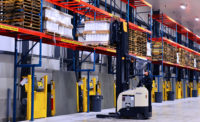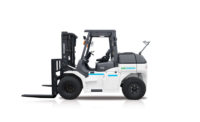When Amazon acquired Whole Foods Market, it set the stage for what was to become a cross-industry collaboration of retail meets e-commerce.
Fast forward to today, and e-commerce penetration is expected to at least triple in the next decade, according to new research from Bain & Co., Boston, Mass., and Google, Mountain View, Calif.
Here’s how automation, energy efficient solutions, employee welfare features and e-commerce capabilities enable cold storage construction providers to meet grocery retailers’ and warehouse providers’ needs.
From in store to online
According to Refrigerated & Frozen Foods’ 2019 State of the Industry report, the cold food and beverage industry is experiencing a major marketplace disruption, with e-commerce, direct-to-consumer (DTC) and grocery delivery services becoming more prevalent.
In fact, more than six out of 10 (63%) grocery store shoppers interact with their supermarket digitally, up from the 56% found in 2017, as presented by the Retail Feedback Group, Lake Success, N.Y.
Meanwhile, global food e-commerce sales are forecast to nearly triple through 2023, rising to $321 billion and accounting for nearly 5% of total e-commerce revenues, according to Packaged Facts.
And, warehouse construction has reached unprecedented levels in the United States due to e-commerce demand, according to a CBRE study. For instance, in-progress warehouse construction in the United States totaled 255 million square feet at the end of this year’s first quarter. And, slightly more than 70% of warehouse space under construction is being built on speculation, meaning that developers began construction before securing occupants for their buildings.
“CBRE is tracking client needs for direct-to-consumer delivery. These facilities come in all shapes and sizes from smaller, faster turn facilities to 100-foot clear, automated, rack-supported facilities. We also see a significant uptick in food processing and produce grow facilities showing a clear demand for reliable, high-quality foods,” says Tripp Eskridge, managing director of industrial and logistics project management for CBRE, Los Angeles.
That’s why there is a push in the grocery distribution arena to pursue automated product distribution, given the speed-to-market required for the end user, adds Michael Jones, president, Primus Design Services, LLC, Woodstock, Ga.
“In order to be competitive with online retailers, food retailers are having to find creative, efficient ways to keep pace with the instant gratification required by consumers,” he says. “Automation is one method, which is helping them maintain their relevance.”
But, while the emphasis on e-commerce, DTC and last-mile deliveries is definitely on the rise, it is not yet directly affecting current food distribution facility design concepts, as outlined by Timothy Nguyen, regional vice president for ESI Group USA, Hartland, Wis.
“Infrastructure and multi-zoned-controlled environments are still a premium, and product storage capacities requirements for maximized SKU utilization is still the primary driver in warehouse layouts,” he says. “Automation will be key in smaller case deliveries instead of bulk pallet deliveries. Automated material handling systems to maximize densities, mix case palletizing and piece picking systems for e-commerce home delivery options will be integral in the outbound shipping configurations.”
Similarly, consumer demand as it relates to e-commerce is just part of the equation.
“The clients that are investing have plans in place that include modifying their approach to distribution centers to address the last-mile experience. These plans include smaller scale distribution and larger consolidation-type warehouses located within major metropolitan areas and near airports in order to satisfy the direct to home delivery market,” says Daren Sealover, project executive, Graycor Construction Co. Inc., Oakbrook Terrace, Ill. “Traditional business models established retail centers as the revenue generators and the distribution centers as necessary part of the business. That model is changing. The distribution center in no longer the back room to the store. It has become a showcase of the best of their business, how far they have come and where they are going.”
Either way, if you are in the food industry, you need to be involved in e-commerce and DTC projects, as all segments of the food industry are moving this way, says Mark Moore, president, CMC Design Build, Inc., Quincy, Mass.
“The disruptor influence got its start in the e-commerce world,” he adds. “The speed-to-market is huge for all of these clients. It is like an arms race. They need to be out front to grab market share in a new field. That means we have to file permits and start construction with less than complete information. The projects also tend to involve more changes to the owner program.”
Employee welfare areas RECRUIT WORKERS
Employee attraction and retention continues to be a concern for many of today’s cold food and beverage processors. That’s why employee welfare areas are becoming more commonplace in the design and architecture of manufacturing plants.
“Amenities and more robust employee welfare areas are helping to entice and keep employees on board,” says Chris Jarc, vice president and project manager at Hixson Architecture Engineering Interiors, Cincinnati, Ohio. “Employee welfare areas are now gathering spaces, and companies are choosing to incorporate amenities such as on-site daycare, outdoor decks, basketball courts and comfort rooms for private use (e.g., nursing moms, prayer).”
In fact, many clients are requesting amenities that allow employees to do more than just “eat your lunch and go back to work,” says Jones..
“We are seeing recreational areas with games, multi-media cafes and even employee stores to make the experience more fulfilling for the staff,” adds Jones.
And, employee wellness and retention continue to be major factors to consider when building a new facility.
“Some of the options that we’re including in new construction projects include more comfortable break areas with things like USB charging ports throughout, TVs, video games, foosball tables and an open market area for lunches, which provides a fresh, healthy meal option for employees,” says Steve Tippmann, executive vice president, Tippmann Group, Fort Wayne, Ind.
What’s more is, employee welfare areas have evolved into a recruiting tool for employers, according to Carl Morse, senior project manager at A M King, Charlotte, N.C.
“It is no longer just a warehouse breakroom for employees, but rather a place for people to relax,” he says.
AUTOMATION, ENERGY EFFICIENCY OVERRULE FOOD SAFETY
Food safety regulatory requirements are no longer the hot topic. The Food Safety Modernization Act (FSMA) has been in effect for some time now, and facility operators have a better grasp on what is required, Morse adds.
“Energy and operational efficiency continue to be strong talking points for all projects,” he adds.
For example, cold food and beverage processors are moving away from traditional ammonia refrigeration systems to pre-package penthouse units, cascade systems and other types of systems to reduce the charge, maintenance costs and process safety management programs, says Sealover.
“Ammonia refrigeration uses a great deal of electrical power and cooling water,” he adds. “The cost savings by reducing energy usage and the environmental responsibility to reduce water usage are showing up as part of the cold storage client’s requirements.”
An additional trend pertains to transcritical CO2.
“It’s popular in Europe, but so far adoption has been slow in the U.S.,” adds Andy Campbell, senior refrigeration engineer for LEO A DALY, Omaha, Neb. “We foresee a big disruption when that finally happens. Players who master this technology will be able to compete better, on tighter budgets with faster delivery.
A M King utilizes pre-packaged, low-charge refrigeration units to minimize refrigerant charge, alternate refrigerant types, automated conveying and racking systems “to improve operational workflow, energy efficient systems inclusive of LED lighting, PV solar, interactive building automation systems, high efficiency motors and alternative means of fire suppression to maximize the cubic volume of high-pile storage locations,” says Morse.
On the other hand, automation is standard in regulating the temperature-controlled environment, according to Josh Currie, senior project manager for Fisher Construction Group, Burlington, Wash.
For instance, Fisher developed a USDA-certified lab for Newold’s Tacoma, Wash., facility. Fisher also built NewCold’s fully automated facilities in Tacoma, Wash., and Burley, Idaho, which possess a variety of state-of-the-art technology, including warehouse management systems with complete track-and-trace technology.
“We see a reduced focus on LEED certification. However, in parallel with the emerging demands of globalization, climate change, resource depletion and population growth, the cold storage design-build industry is perpetually evolving in order to maximize energy use, enhance food safety and generate logistical efficiencies throughout the supply chain,” says Currie. “Many of the facilities Fisher is building use automation to some degree. Some of these facilities adopt state-of-the-art, fully-automated warehousing, which includes receiving, picking and retrieving systems (with minimal human touch from freezer to truck), while others utilize less-intensive, semi-automated systems such as racking to automated truck loading systems.”
Meanwhile, Internet of Things (IoT) and blockchain technology continue to infiltrate the cold storage construction industry.
“Consumers want to know more about the food chain than ever imagined, and while this is highly focused on ingredient sources and processing methods, it’s only a matter of time before consumers will look to validate storage temperatures and other aspects of the food chain,” says Walker Mattox, president of GraySolutions, a unit of Gray Construction, part of the Gray family of companies, Lexington, Ky. “As suppliers look to meet this demand, they will need to incorporate these elements into the design and construction of new facilities.”
Likewise, 90% of pallet positions involve automation, from utilizing semi-auto guided turret trucks to fully-automated facilities, says Tippmann.
“The facilities we are building today are more energy efficient than anything we’ve ever built,” he adds. “Variable speed drives, LED lighting, lithium-ion batteries and innovative refrigeration systems are all factors contributing to our buildings’ power consumption running at less than half that of the cold storage facilities we built just 15-20 years ago.”
Another new project type emerging is transforming spec warehouses into food facilities to increase speed to market.
“This presents a challenge to design teams because not everyone has the expertise to take a facility not originally made for food and turn it into food facility,” says Campbell. “They don’t have the drains, the structure, the floor loading they need. It requires thoughtful engineering to convert those into a safe place for food preparation and storage.”
For example, LEO A DALY is currently designing a new refrigerated and frozen foods distribution campus for PUBLIX in McLeansville, N.C. Some technology highlights include 3D modeling complete with virtual reality site inspections from an operations point of view, as well as a more refined style of evaporators to reduce charge ammonia system.
E-commerce continues to dictate the future of cold storage construction. Thankfully, many of today’s A&E and design-build firms are in position to implement energy efficient features that improve employee well-being and enable cold food and beverage processors to be all things to all consumers.
Letter: A Year of Success Under a New Brand

As the chairman of the Controlled Environment Building Association (CEBA), it is my pleasure to introduce Refrigerated & Frozen Foods’ 2019 North American Cold Storage Construction Guide, which showcases CEBA members.
Every year, CEBA, a core partner of the Global Cold Chain Alliance (GCCA), Alexandria, Va., collaborates with Refrigerated & Frozen Foods to provide readers with this comprehensive list.
Formerly known as IACSC, CEBA adopted a new name and mission last year to fully represent the expert builders who design and construct controlled-environment buildings, including cold storage warehouses, food processing facilities, clean rooms, pharmaceutical facilities and foodservice and retail distribution centers. Anyone looking to build, renovate or modernize a first-rate, innovative facility should look to the CEBA guide to use the most experienced designers, contractors, manufacturers and suppliers around.
In addition to the CEBA guide, the CEBA Built by the Best awards has achieved high prestige and recognition, with each year’s award recipients highlighted at the annual CEBA Conference & Expo, which will be Nov. 14-16 at the Loews Miami Beach Hotel in Miami. The CEBA Conference & Expo is where about 300 building professionals, suppliers and end-users gather to learn and do business with each other in this robust marketplace of controlled-environment buildings. CEBA offers the best education, industry advocacy and business development opportunities in the cold facility construction industry. We keep our members on the cutting edge of the latest trends and techniques, allowing CEBA members to maintain expertise in this highly skilled, niche market.
While many could claim to design, build and maintain such facilities, we are leaders in this area, and anyone building or maintaining such a facility should look to us for expertise.
Regards,
Tim Nguyen
Chairman, CEBA
Regional vice president, ESI Group USA











